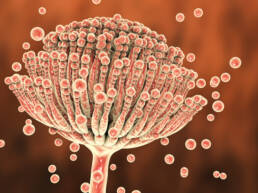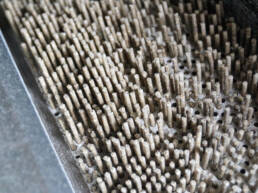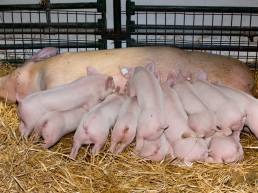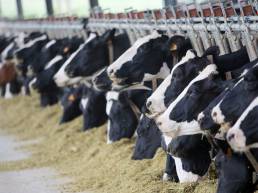Problems caused by mycotoxins are increasing due to climate change. Mycotoxins can be produced at various stages, for example when crops are still in the field, during harvest, and during storage. Climate change is causing the average temperature to rise. Higher temperatures, combined with high humidity, increase the risk of mould growth and mycotoxin formation. This means it is becoming increasingly important to monitor mycotoxins. Mycotoxin-related problems have been common in poultry and pigs but now also form an increasing problem in cattle.
Various mycotoxins play a role in cattle. Strict concentration limits apply to aflatoxins in cattle feed because aflatoxin metabolites are excreted in milk. DON in cattle feed can reduce the volatile fatty acids in the rumen, reduce the microbe population, lower milk production and increase the incidence of inflammations. Higher concentrations of DON can lead to lameness and mastitis. ZEA can cause hormonal issues in cattle, resulting in follicular cysts for example. Lesser known mycotoxins can also be problematic for cattle. Fumitremorgin, gliotoxin and mycophenolic acid can have adverse effects such as mastitis and pneumonia. Gliotoxin also suppresses the immune system. Although problems caused by exposure to low levels of mycotoxins are often less visible, low levels of mycotoxins can also be harmful to animals and can impair the animal’s immune function and production. The adverse effects of mycotoxins often only become visible some weeks or months after feeding animals with contaminated feed.
The negative effects depend on the type of mycotoxin, exposure to the mycotoxin and the age, gender and health status of a cow. Different mycotoxins can strengthen each other synergistically. Mycotoxins often have a greater impact on high producing cows. In the past, clinical symptoms often made mycotoxin infections clearly identifiable.
Tox-Aid® has been specifically developed to control mycotoxins. It can be administered to cattle, pigs and poultry. Tox-Aid® contains inactivated yeast, clay minerals and a special mixture of herbs. The clay minerals bind the mycotoxins and the inactivated yeast produces enzymes that deactivate the mycotoxins, making them harmless. The natural herbs support the animal’s liver. Tox-Aid® protects the animal from the negative effects of mycotoxins.
We are seeing good results in practice when dairy cattle are administered Tox-Aid®. Please contact the E.F.S. nutrition team if you have any questions about mycotoxins for all species of animals.
You may also like
The battle against harmful mycotoxins
October 21, 2022
Despite being discovered over 50 years ago, mycotoxins remain a relevant theme in farming and feed production today. These secondary metabolites produced by certain moulds have detrimental effects on an animal’s health…
Tox-Aid® study
September 7, 2021
E.F.S. recently had an in vitro study performed using the mycotoxin deactivator Tox-Aid® which was developed by E.F.S. This study measured the deactivation capacity of Tox-Aid® and three other, renowned mycotoxin…
Heat stability of Tox-Aid®
April 6, 2021
E.F.S. is always evolving! As a result, we’re constantly on the lookout for innovative knowledge about our products. In this context, we studied the heat stability of Tox-Aid®, our mycotoxin deactivating product. A…
Tox-Aid® organic authorisation
June 29, 2020
Tox-Aid® is on the organic input list! Tox-Aid® has been authorised for use in organic feeds to limit the negative effects of mycotoxins in the animal. This product has a three-stage effect, i.e. deactivation by means…
Tox-Aid®: Masked Mycotoxins
January 28, 2017
E.F.S. believes that nature has a solution for everything. Mycotoxins are part of a natural process and it appears that masked mycotoxins are present in crops, feed materials and feed. Maybe you have already heard the…
Mycotoxins
August 16, 2016
Nowadays, adequately controlling the growth of bacteria and fungi is possible, but mycotoxins still pose a risk due to their impact on animal health. In practice, mycotoxins still often seem to be forgotten. However,…
Tox-Aid®: Mycotoxins in dairy farming
July 23, 2016
Mycotoxins are an underestimated problem in livestock. More knowledge has been gained in the past few decades about fungi, mycotoxins and their effects. Therefore fungi are more and more recognised as a problem at…
Should we worry about mycotoxins in dairy feed?
May 23, 2011
Cows are capable of detoxifying limited amounts of mycotoxins in the rumen. This is on condition that the cow's rumen works properly. However, some mycotoxins have a very negative impact on the rumen flora which…











